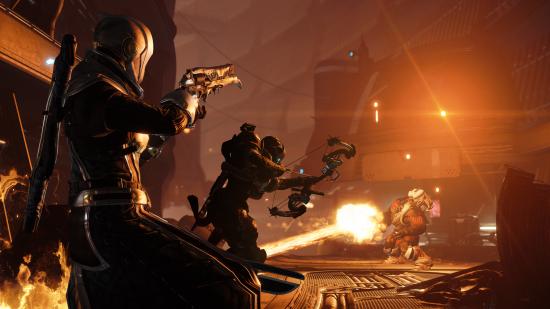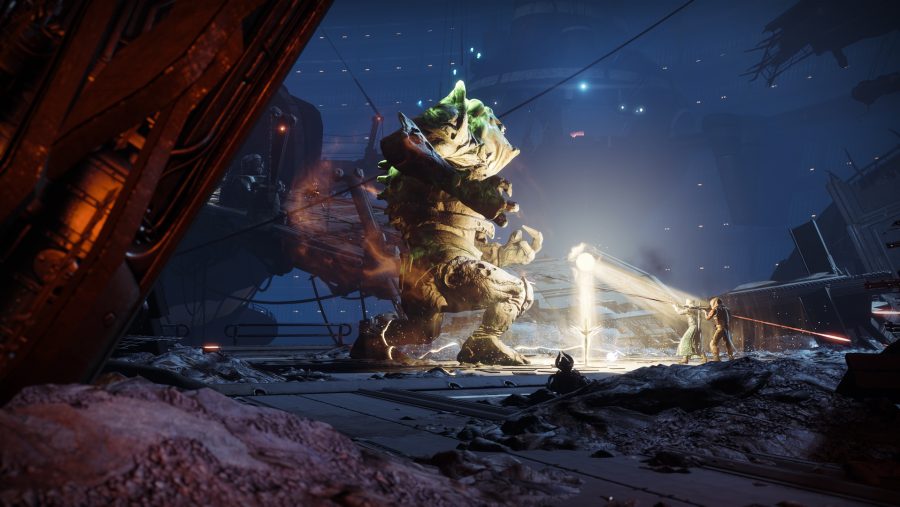Cayde-6 is dead. Shot with his own gun by Uldren Sov – a character you won’t be familiar with if you’re not hot on the lore – Destiny 2’s mascot is no more. His final hour is a fun one, though, and a promising start to an expansion that has a ludicrous amount of weight on its shoulders. Forsaken needs to ‘fix’ Destiny 2, and – at least as far as the story campaign goes – it seems like it’s on the right track.
Forsaken deals with the fallout of a massive jailbreak. That exodus of prisoners makes up the game’s introductory mission: as the Prison of Elders erupts and its inmates run wild, your Guardian and Cayde-6 intervene in an attempt to restore some kind of peace. Spoilers: you fail. But that’s good for this expansion. With a multitude of super villains now let loose into Destiny 2’s new Tangled Shore location, Forsaken has plenty of fresh narrative-led gameplay for you to engage with.
The Prison Break mission itself is a typical Destiny 2 set-piece chapter: set in its own self-contained area, you barrel along at pace as Fallen and Hive prisoners riot and tear each other apart. Cayde-6 doesn’t fight alongside you, but he can often be seen firing his hand cannon from a gantry above, or casting an elaborate display of bright-orange particle effects as he unleashes a solar super. His dialogue is typically snappy, creating a buddy-cop feel to the proceedings as you both gun down anyone who won’t get back in their cell (literally everyone).
There’s an emphasis on firefights here – there’s barely a moment when your weapons are lowered – and so Prison Break is an ideal introduction to Forsaken’s new weapon slot system. When it comes to moment-to-moment gameplay it’s this new loadout design that will ensure Forsaken feels very different to year one of Destiny 2. In short: weapon types that were once limited to the heavy ‘power’ slot can now be equipped in your primary or secondary slot, meaning you can fire the likes of fusion rifles, sniper rifles, and shotguns pretty much all of the time, rather than only when you’ve scavenged five or six rounds of rare purple ammo.
There’s still some of Destiny 2’s original system left: each of the three slots remain dedicated to specific weapon groups, which helps balance your loadout. The major adjustment means some guns that were classified as ‘power’ weapons in year one can now be found as kinetic or special ammunition variants, liberating them from their single slot. For example, now fusion rifles are considered energy weapons instead of power weapons, the ever-popular Merciless is now in slot two and consumes green special ammunition, instead of the heavier power ammo.

You’ll need to reforge your relationships with a lot of weapons, then. While a shotgun can now be your primary weapon and fired with reckless abandon, a kinetic variant is nowhere near as lethal an old power-ammo version, and so it’s not a case of turning enemies into wisps of ether with every pull of the trigger. But there’s no denying that sliding around unleashing buckshot hell is simply a much more fun way to play. For a game with unparalleled gunfeel, it’s great that Destiny 2 finally has the arsenal variety that it should have had from day one.
As Prison Break is built up from a variety of Destiny 2’s most common objectives it can serve as a great testing ground to get to grips with your new loadout potential. Moving between locations is done via vast corridors with multiple levels, making it ideal to reacquaint yourself with a sniper rifle. At the mission’s mid point you’ll be required to fend off waves of swarming Hive in a tight, crowded space, which demonstrates the power of the shotgun. An assault by Destiny’s much larger ogre enemies reminds you that the heavy slot still exists – that there’s still benefit in delivering a punchy rocket to the face.
In order to emphasise that the gunplay can now feel so different, the mission throws you through much of the same routine that the Red War campaign provided. While the narrative thrust and elaborate cinematics make it a fun introduction to this new chapter, it doesn’t present you with Forsaken’s biggest ideas upfront. That’s not a problem, but it’s hard to step away with any thoughts grander than ‘it’s another Destiny 2 campaign mission’ when it comes to the actual construction of the scenario.
The hours after Prison Break promise something more ambitious, though. Bungie has already revealed how the campaign will progress from here: the newly liberated super villains, known as the Barons, need to be tracked down in boss battle missions. By their designs alone they promise something very different to Destiny 2’s original campaign: a series of encounters, not unlike those in Dark Souls, in which you fight foes with individual personalities and combat tactics. Destiny has typically saved its most flavourful villains for its raids, but it appears that this time they are the backbone of the Forsaken campaign.
Prison Break itself didn’t blow me away, but the course it plots for the rest of the expansion demonstrates that this is a project very much built upon an entire year of being bombarded with fan criticism. Bungie has definitely been listening, and there’s a chance that this time the team has got it right.

